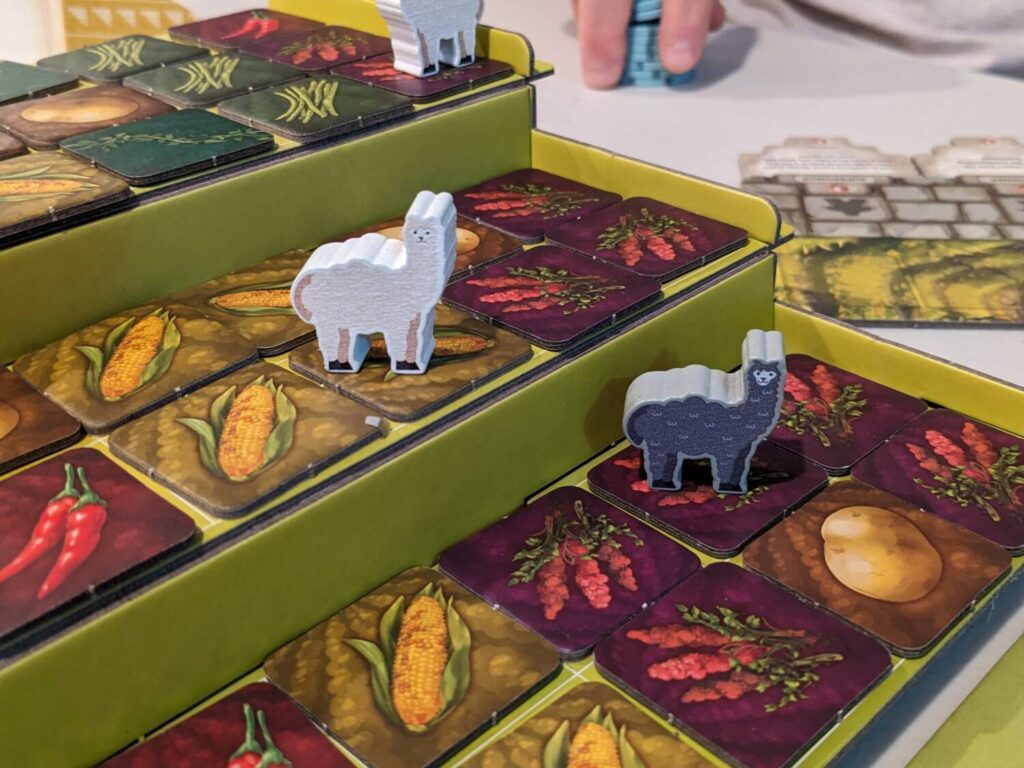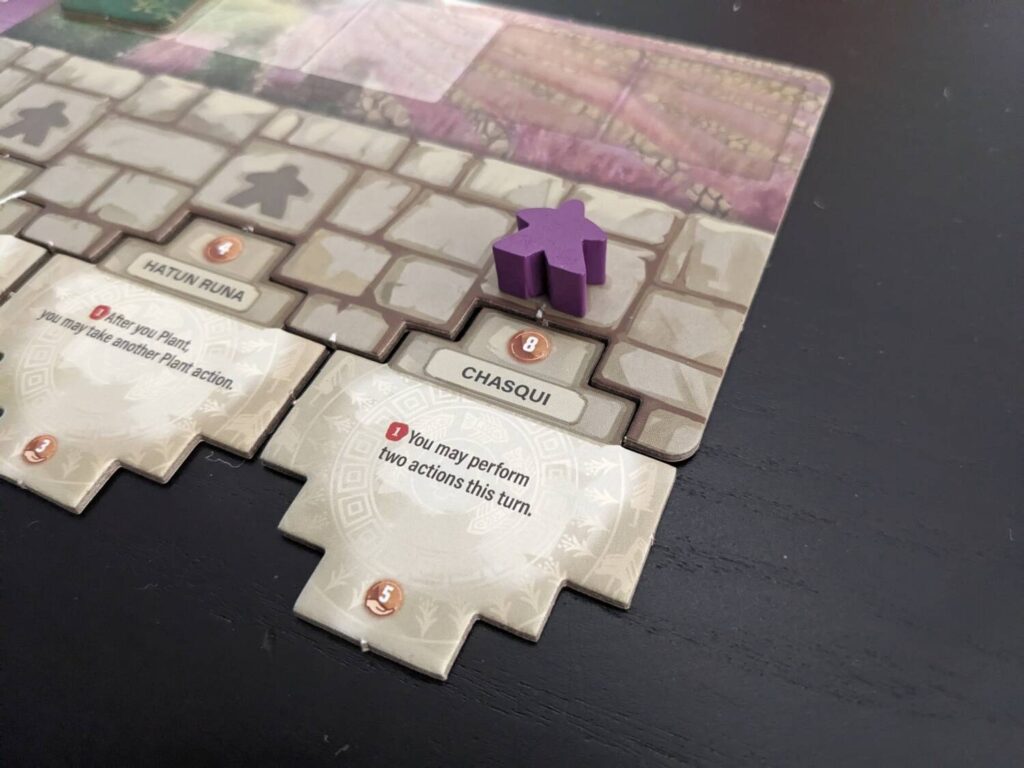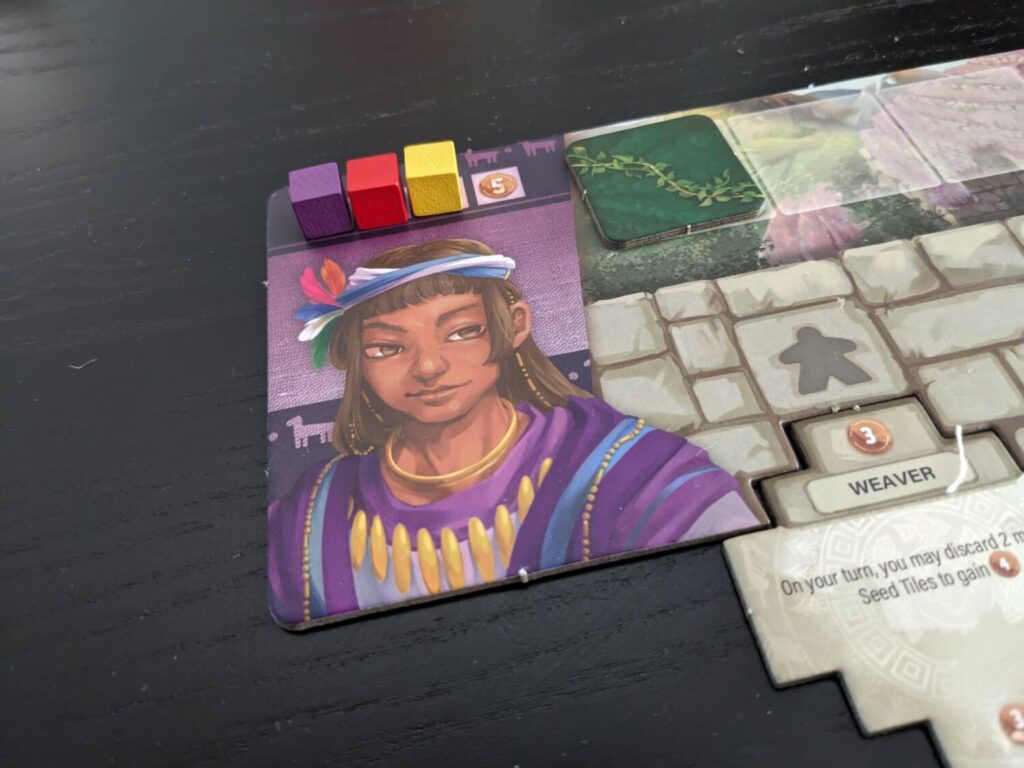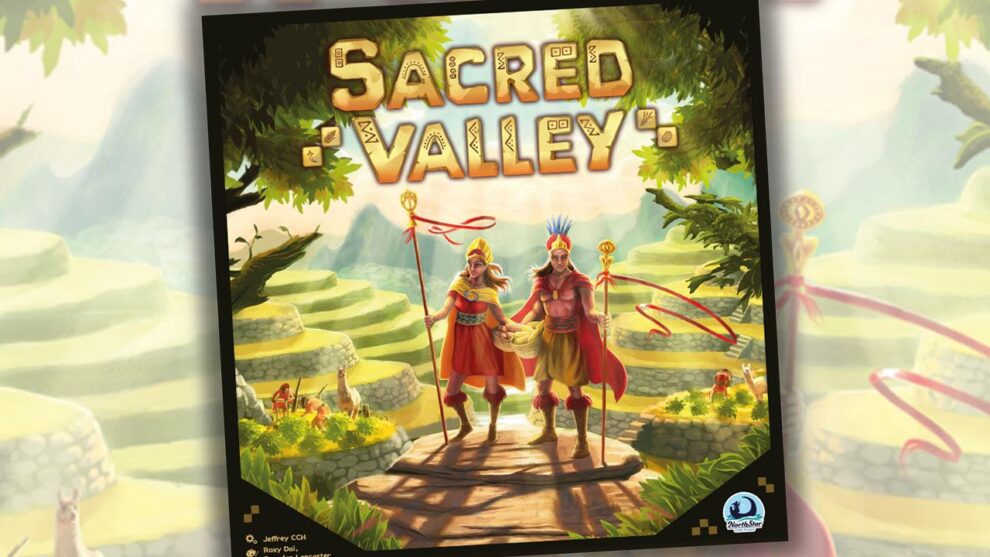Disclosure: Meeple Mountain received a free copy of this product in exchange for an honest, unbiased review. This review is not intended to be an endorsement.
When the folks at NorthStar Game Studio call, I always answer.
That’s because NorthStar published one of my ten favorite games of 2023, Inheritors, and they also delivered my second-favorite solo game of 2023, Eila and Something Shiny. Both games were designed by Jeffrey CCH, so when NorthStar offered a review copy of their upcoming Gen Con release, Sacred Valley, I jumped at the chance to cover it.
The game arrived quickly, and after opening the box I was greeted by a rulebook printed in a very large typeface, making it very “old man friendly” because my eyesight gets a little worse every year. One pass of the rules and I was golden, and after my first play with the kids, one thing became clear right away—Sacred Valley is family-weight gold. The simple ruleset and limited actions made the game instantly accessible, and my 10-year-old commented that they would play Sacred Valley again right away “if we didn’t need to eat dinner right now.”
So, my kids love Sacred Valley. What did I think of the game? Read on.

There Are Only Four Actions
When you can teach a game from the back of a player screen, you know the teach is gonna be quick.
Sacred Valley (the game’s title is 印加聖谷, or Urubamba Valley, in some regions) is a 3-5 player tile placement game with elements of area majority scoring that plays in about an hour, regardless of player count. As farmers in Peru during the time of the Incan Empire, players compete to earn the most money by planting seed crops then harvesting those crops for money, while taking advantage of local specialists to boost actions and increase end-game scoring opportunities. Seeds are planted on terrace spaces, and when all spaces are filled with seeds, workers and/or alpacas (which boost the value of a tile), the game ends after players cash out on one final harvest.
Turns are even shorter than that paragraph.
Players can choose to take a single coin if they are out of cash, an action which I’ve not seen anyone take across my three plays of Sacred Valley. There are three other action choices:
- Plant one of the game’s five seed types using an available seed tile in their warehouse onto an empty space on a terrace. This scores “Harvest Points” equal to the value of the size of the section that seed was added to
- Harvest, by scoring cash equal to the value below the player’s Harvest Point marker
- Purchase, by buying any number of seeds from the “Catu” (market), acquiring “Camayos” (specialists) and/or picking up technology cubes. Camayos offer ongoing or one-time powers that are added to a player mat, while technology cubes allow farmers to plant seed types beyond their starting specialty.

Save for the purchase action, turns are lightning quick. And because the terrace spaces are always limited to the same number each game, larger player count games turn into a tighter fight for real estate because you have more competition and less turns to do everything.
The real tension in Sacred Valley, particularly in lower-player count games, came in finding as many ways to profit early by building large patches of the starting crop each player could access (corn, quinoa, potatoes, beans, and chili). Getting progressively bigger payouts for harvests—or piggybacking on another player’s early investments by racing to claim the limited technology cubes of that other player, then planting similar seed tiles—ends up being huge as terrace space becomes more limited late.
Conversely, the game has a fun way of cutting off other players by using vine tiles, which signify a break in a batch of crops by scoring a limited number of Harvest Points but also ending a potentially large section of someone else’s massive beans area, for example. Keeping a vine tile or two in my warehouse to cut off another player always had big implications, so it feels like savvy players will always need that vine option.
On its own, planting seeds and harvesting them for cash was a bit dry after a couple plays. The real juice in Sacred Valley comes with the Camayo powers. That’s because Camayos give each player game-breaking powers that add more spice to turns, particularly the one-time powers that can be used immediately or saved for later. I was surprised how often a second plant action or the opportunity to double the value of Camayo tiles at the end of play became so valuable, so I found Camayos to be the best part of the design.

Bring Your Family to the Valley
Across my three plays—two with my family, one with my review group—I found that when my family joined me at the table, they absolutely loved Sacred Valley. My 10-year-old and seven-year-old love this game. It’s so easy to teach it to kids, and all the game’s actions are listed on the player screen used to keep money secret during play. They enjoyed placing tiles and making money, and I was surprised that they were also able to track why Camayos were so important even early in our first play. Our first game took about 50 minutes, and usually my kids run for the hills if games take longer than half an hour.
I highly recommend Sacred Valley as a family-weight tile-laying experience. I did a three-player game with my review crew (all seasoned gamers), and my sense is that while players enjoyed the game, they wouldn’t come back to Sacred Valley unless someone else suggested it. While the limited choices made for a snappy play, there weren’t many “wow” moments for those players.
Outside of that, my issues with Sacred Valley are tied mainly to replayability as well as the production. I love the font size in that rulebook, but the text on the Camayo tiles is so small that we (“we” being all the adults AND all the kids) had to stand over the tiles to see what they said. After a few rounds of my first game, I began handing the board of Camayo tiles to the active player so that they could peruse their options more closely.
A secondary complaint—I don’t know why that Camayo tile board is formatted to hold the tiles in a snake-like line. As a result, there are two tile spaces that require a player to pay one coin extra for taking the tiles…but there’s a tile space right next to one of them that does not. The two spaces below that also do not require a coin. It’s just a strange design choice; why not just have the five tiles run in a column from top to bottom, like the seed market does?
Sacred Valley is another solid production from NorthStar that keeps the rules overhead light and the decision space hovering at medium. That leads to accessibility that will ensure—at least with my family—Sacred Valley will hit the table from time to time at home. The designer Jeffrey CCH continues to put out quality experiences so sign me up for whatever is coming next!












Add Comment